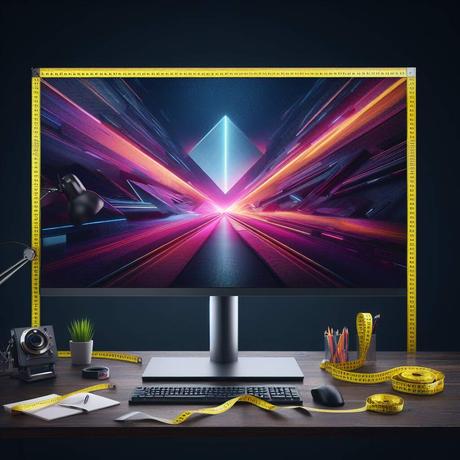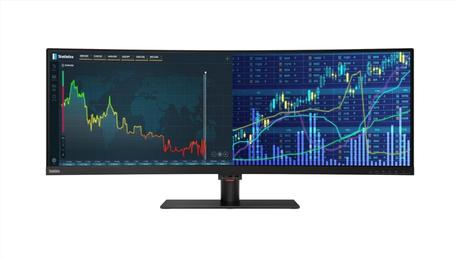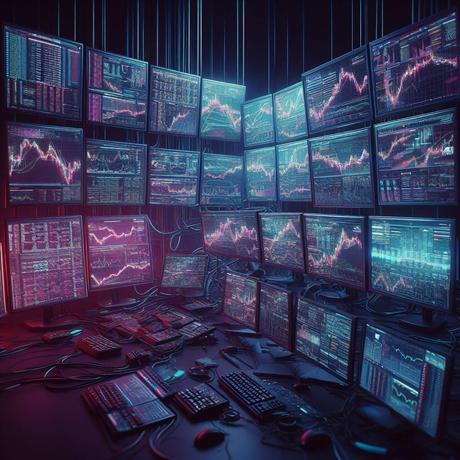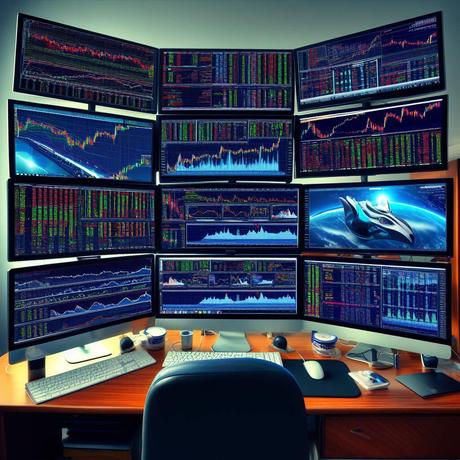Trading in the Indian financial markets requires a well-equipped setup, and one crucial element is the choice of monitors. A multi-monitor setup enhances efficiency, allowing traders to monitor multiple charts and data feeds simultaneously.
In this comprehensive guide, we will explore the critical considerations for selecting monitors for trading, keeping in mind the specific needs of the Indian audience.
How to Choose the Best Monitors for Trading
When purchasing monitors for trading, you must consider several factors to ensure you get a setup that meets your needs. Here are some considerations:

Resolution: Look for high-resolution monitors for trading, such as 4K or at least 1440p. Higher resolutions provide sharper images and allow you to see more details on charts and financial data.
Size and Number of Monitors: Consider the physical size of the monitors and the number you plan to use. Multiple monitors can enhance your trading experience, but make sure they fit comfortably on your desk.
Aspect Ratio: Opt for widescreen monitors with a 16:9 or 21:9 aspect ratio. Widescreen formats are suitable for displaying charts, graphs, and multiple applications side by side.

Panel Type: Choose an appropriate panel type based on your preferences. IPS and OLED panels offer better color accuracy and wider viewing angles, which can be beneficial for detailed financial charts.
Refresh Rate: A higher refresh rate, such as 144Hz or more, can contribute to smoother motion on the screen. This may be particularly useful for fast-paced trading environments.
Response Time: A low response time helps reduce motion blur, which is crucial when tracking fast market movements. Aim for the panels with 5ms or lower response times. This goes hand-in-hand with the refresh rate.
Connectivity: Ensure the monitors have the necessary ports for your trading setup. HDMI, DisplayPort, and USB ports are common requirements.
Adjustability: Look for monitors with adjustable height, tilt, and rotation stands. This allows you to customize the viewing angles for maximum comfort when setting up monitors for trading.
Bezel Size: Thin bezels are preferable, especially if you plan to use multiple monitors in a seamless configuration. Minimal bezels help reduce visual distractions.
Color Accuracy: For traders who rely on accurate color representation, consider monitors with good color accuracy and coverage, especially if you are involved in technical analysis.
Eye Comfort Features: Monitors with blue light filters and flicker-free technology can reduce eye strain during prolonged trading sessions.
How to Setup Multiple Monitors for Trading
When setting up multiple monitors for trading, there are several key considerations to ensure a practical and comfortable trading environment. Here are some tips:
Monitor Placement: Arrange your monitors to minimize head movement and allow for easy viewing. Consider a symmetrical setup with the primary monitor in the center.

Resolution and Orientation: Ensure all monitors have consistent resolutions and orientations. Matching resolutions prevent visual discontinuity, and consistent orientations (landscape or portrait) help in a seamless workflow.
Bezel Awareness: Be mindful of the bezels between monitors. Thin bezels or monitors with minimal borders can create a more cohesive and immersive display.
Graphics Card: Check if your graphics card supports the number and resolution of monitors you plan to use. Ensure that it has the necessary ports for connecting multiple monitors.
Cable Management: Organize cables neatly to avoid clutter and tangling. Use cable clips or ties to keep cables together and out of sight.
Monitor Calibration: Calibrate each monitor to ensure consistent color accuracy across the entire setup. This is crucial if you rely on precise color representation for trading charts and data.
Primary Monitor Placement: Designate one monitor as the primary display for your main trading workspace. This is typically where you place your primary charts and trading platform.
Task Allocation: Assign specific tasks to each monitor based on your trading workflow. For example, use one monitor for market data, another for news feeds, and another for executing trades.
Adjustability: Ensure each monitor is adjustable for height, tilt, and rotation. This allows you to fine-tune the viewing angles for optimal comfort and visibility.
Lighting Conditions: Consider the lighting in your trading space when setting up the monitors for trading. Position monitors to minimize glare and reflections. Use ambient lighting that is easy on the eyes during extended trading sessions.
System Performance: Verify that your computer’s hardware can handle the increased workload of multiple monitors. A powerful graphics card and sufficient RAM are essential for smooth operation.
Backup Power: Invest in a reliable, uninterruptible power supply (UPS) to protect your setup from power fluctuations and outages. This ensures uninterrupted trading even during electrical issues.
Software Configuration: Configure your operating system to recognize and manage multiple monitors effectively. Adjust display settings, resolution, and orientation through the control panel or system preferences.
Workspace Ergonomics: Set up your trading desk with ergonomics in mind. Position monitors at eye level to reduce strain on your neck and eyes. Use an ergonomic chair and consider an anti-glare screen for added comfort.

Considering these factors will help you create a well-optimized and efficient multiple-monitor trading setup tailored to your specific needs.
Where can you buy monitors for trading in India?
You can explore online and offline retailers to buy monitors for trading in India. However, please note that specific product availability and retailers may change over time. Here are some of the suggestions when looking to purchase monitors for trading in India:
Online Retailers:
Electronics and Computer Stores: Visit local electronics and computer stores in your area. Popular chains and independent retailers often carry a variety of monitors.
Specialized IT Markets: Explore major cities’ specialized IT markets or technology hubs. Places like Nehru Place in Delhi or Lamington Road in Mumbai are known for a wide range of electronics.
Brand Outlets: Check official brand outlets or authorized dealers for specific monitor brands. This can ensure that you get genuine products with warranty support.
E-commerce Platforms: Besides Amazon and Flipkart, consider checking other e-commerce platforms that may offer a selection of monitors.
Local Computer Fairs: Attend local computer fairs or exhibitions where vendors often showcase and sell computer peripherals, including monitors.
IT Malls: Visit IT malls or technology-centric shopping complexes, which often have multiple stores selling computer hardware and accessories.
Before purchasing, it’s advisable to read customer reviews, compare prices, and check for warranty and return policies. Additionally, confirm the specifications and compatibility of the monitors with your trading setup.
This concludes the comprehensive buying guide on best monitors for trading. If you are interested in knowing how to power them all, we got you covered! Prefer Laptop vs Desktop for Gaming/Work? Avoid it!

